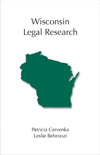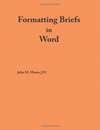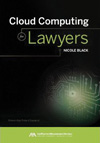Verdict:
Touchdown! • It's a Keeper • Not for Me, Maybe for You • A Tree Died for This?

Verdict: It's a Keeper
Wisconsin Legal Research
By Patricia Cervenka & Leslie Behroozi (Durham, NC: Carolina Academic Press, 2011). 200 pgs. $25. Order, www.cap-press.com.
Reviewed by Margaret S. DeWind
The authors of Wisconsin Legal Research describe their likely audience as new law- and paralegal-school students, summer associates attending law school outside Wisconsin, and librarians, and they suggest that experienced attorneys new to the state might also find the book helpful. I fall in none of these categories but nevertheless found many things in the book useful, either as reminders of things I have learned but forgotten or as introductions to new sources or procedures.
Cervenka and Behroozi, attorneys and librarians with the Marquette University Law School library, first briefly describe the legal-research process and the distinction between primary and secondary legal resources. The bulk of the book focuses on finding and verifying relevant (mostly Wisconsin) law: the Wisconsin Constitution, statutes, regulations and other administrative law, and cases. Also included are chapters on legislative history and legal citation.
Readers new to the Wisconsin legal system probably will find most helpful the authors' descriptions of state-specific aspects of laws, such as the numbering system and elements of history lines for Wisconsin statutes, the relation of court rules to the statutes, and ways to locate information about Wisconsin administrative agencies. And even attorneys with many years' legal-research experience will probably make discoveries. For example, I had not known before that the U.S. Supreme Court's website contains full opinions from 2005 on and that the official version of the Wisconsin Statutes gives dates for only post-1971 statutory changes.
The authors acknowledge the widespread availability of online resources but also that they often are expensive. I especially appreciate their candid caution that persons doing research for law firms and other organizations must first find out the parameters of their employers' contracts with commercial service providers (as, for example, when using Westlaw or Lexis/Nexis). It also is useful to be reminded that although most attorneys now do the majority of their work, whether reading or writing, on computers, many resources still are not available electronically. (Readers with generous research budgets or limited access to bricks-and-mortar law libraries can skip the authors' description of doing research with hard-copy sources.)
A few aspects of the book are less than ideal. As is common with all hard-copy publications (and many electronic ones), some URLs in the book no longer work. Similarly, some of the explanations of navigating websites were difficult to follow, perhaps because of challenges inherently posed by attempting to translate graphics (the layout of Web pages) into words. Finally, I would have appreciated more mentions of free online services and sources, for readers whose research budgets are not unlimited.
Overall, though, I found Wisconsin Legal Research comprehensive, easy to understand, and worth the time it took to read. I commend the authors for using their knowledge and experience to help Wisconsin lawyers and laypeople find their way into and through Wisconsin's laws.
Margaret S. DeWind, U.W. 1989, is an attorney editor with State Bar of Wisconsin PINNACLE and a copy editor for the Wisconsin Lawyer magazine.
 Verdict: It's a Keeper
Verdict: It's a Keeper
Formatting Briefs in Word
By John M. Miano (Colosseum Builders Inc., 2011). 292 pgs. $22.50. Order, www.amazon.com.
Reviewed by Terry Dunst
Formatting Briefs in Word begins with a discussion of how technology has shifted the burden of formatting briefs from skilled printers to lawyers and legal assistants, with mixed results. Emphasizing this point, author John Miano quotes Justice Antonin Scalia: "the filed product is often disastrous." The brief's writer may lack formatting skills, and sometimes court rules do not "encourage readability in briefs" and instead are designed to "rein in abuse by lawyers." Miano takes on the challenge of teaching lawyers and legal assistants to format documents for improved readability within a system of rules that may discourage that objective.
Miano has largely succeeded. Any lawyer with basic computer and Microsoft Word skills who spends time working through this book will save hours formatting future briefs. Even for just one brief, if you correctly use the right tools, a small amount of preparation will lead to large time savings. Once you have formatted a brief for a particular court, formatting all future briefs for that court will be simple and efficient.
Miano's system primarily involves creating specific templates to comply with court rules for the particular type of brief and then using character and paragraph styles for all formatting tasks. Although I have long been vaguely aware that templates and styles were probably useful tools, I typically must use brute mental force to format each new document that I write. This sometimes leads to a reasonable end product but not without a struggle. Still worse is a document formatted by someone even less skilled than myself, in which each paragraph might have a dozen settings. It may look okay if you don't touch anything, but add or delete a word and, to paraphrase Justice Scalia, disaster.
Miano shows how to effectively use Word to generate attractive formatting within a court's compulsory framework. Even specific documents such as a certificate of compliance can be set up once and then auto-generated for each future need. He also covers Word's decidedly useful, but not particularly obvious, specialized formatting techniques and features. For example, Miano gives an excellent overview of typefaces and why, especially in justified paragraphs, Word leaves gaping white spaces for no reason apparent to a typical reader. More important, Miano shows how to overrule Word's default "spaciness" to render a respectable-looking justified line of text. This, too, need only be done once using templates and styles for formatting. Another useful example shows how to insert special characters such as § or ¥, and how to automate insertions. The correct use of styles will also lead to the automated generation of a brief's table of contents.
Miano's system can automate the formatting, freeing writers to focus on writing. As Miano says, good formatting cannot save a poorly written brief, but bad formatting can wreck a well-written one.
Terry Dunst, St. Thomas 2006, is with Bakke Norman S.C., New Richmond, and focuses on municipal law, real estate, estate planning, probate, and bankruptcy. Before entering law school, he worked in the software industry.

Verdict: It's a Keeper
Cloud Computing for Lawyers
By Nicole Black (American Bar Association, 2012). 222 pgs. $79.95. Order: http://apps.americanbar.org/abastore/index.cfm.
Reviewed by Lucy Kelly
In his foreword to Cloud Computing for Lawyers, legal scholar Richard Susskind argues that education about technological innovations can reduce costs and increase the efficiency of a legal practice, and that to make informed decisions, it is imperative to "demystify" technology. An example technology is cloud computing, which everyone who has used a wireless device experiences, but sometimes without realizing it.
Broadly stated, cloud computing (meaning shared software or server resources) raises legal issues (for example, online privacy) pertaining to both attorneys and clients. Thus, it is necessary to make this technology one's own so it works favorably, a powerful ideal made viable by this easy-to-follow book. Nicole Black recognizes that most attorneys have no prior experience with cloud computing, but she maintains it can be learned about easily. She opines that with a basic introduction, anyone can become comfortable using clouds to organize and manage data. She accomplishes, if not exceeds, this goal by approaching concepts from a more familiar legal perspective; more specifically, privacy, security, and practice management are discussed at length. As a result, she conveys in accessible prose how "software as a service" (SaaS) clouds (in which users select applications, but service providers control infrastructure) function.
This exhilarating dissection of cloud risks, advantages, and corresponding regulations helps lawyers evaluate whether to implement cloud resources. Black details cloud benefits; among them are elasticity, scalability, and "automatic off-site data preservation." Then, along with legal ethics consultant Stephanie Kimbro, who contributes a chapter on cloud ethics, and legal technology critic Roland Schorr, who suggests questioning cloud venders on encryption and storage, Black supplies talking points to use when purchasing cloud products. Kimbro also quotes applicable ABA regulations and other states' bar guidelines (the California, North Carolina, and Pennsylvania bars address cloud ethics) on "reasonable care" measures to protect confidentiality and data security in virtual settings.
As a novel product, cloud computing carries some risks, and users may experience service delays and incompatible data formats, but Black helpfully provides a sample service agreement and ideas for contingency planning and loss mitigation before disasters occur.
In addition, Black proposes a plan for attorneys who decide not to include client information in cloud data: using clouds for other business purposes, such as time tracking, firm marketing, or storing forms, so they can still receive cloud benefits without risk to client confidentiality. Perhaps because cloud computing is still relatively new, one significant concept this book does not discuss directly is intellectual property. That said, maybe future studies could investigate how cloud storage affects authors' rights. Even if an attorney decides against cloud resources, this book is essential for situations in which one needs to describe how clouds work, especially in relation to legal principles.
Lucy Kelly is completing a master's degree in library and information science. She works at Marquette University's Eckstein Law Library and the Milwaukee Legal Resource Center.
Have you read a great book that would be of interest to State Bar members? Or one that you want to make sure no one else wastes their time reading? Be a reviewer! Contact us at wislawmag@wisbar.org.
